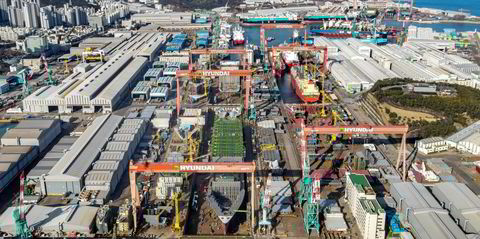European Union member states can now block the sale of tankers for use in Russia if they have “reasonable grounds” to believe they will be used to haul oil in breach of the bloc’s sanctions regime targeting Kremlin finances, according to new EU guidance.
New measures, which came into full force last week, are an attempt two years on from the start of the war to stifle the flow of elderly tankers from established European owners to the fleet hauling Russian oil.
A booming secondhand market for elderly tankers has driven up the price of a 15-year-old aframax by more than 160% since the invasion of Ukraine on 24 February 2022, according to data by Veson Nautical.
The spike in tanker prices has been driven by new players and Russian interests snapping up tonnage to service the country’s oil exports and tap surging freight rates as many European and G7 players withdrew from the trade.
The main surge in asset values was seen in the first year of the war and has since levelled off as the attraction for older vessels paled amid safety concerns and the high costs.
Greek interests alone sold 125 crude and product tankers in the 12 months from February 2022 in confirmed deals worth an estimated $3.4bn. The total could have been as high as 150, or $4bn, with other reported deals.
That compared with a total of 100 tankers sold by Greeks throughout 2021 for total proceeds of $2.8bn, according to TradeWinds research.
The Baltic Exchange’s sale-and-purchase index — which assesses the sale of five-year-old VLCCs, suezmaxes, aframaxes and MR product tankers — has increased by 56% since the beginning of the war.
But some of the biggest price rises have been seen in the oldest tankers as new players have sought to sweat the assets and cash in on bumper freight rates available in the Russian trades, particularly in the earliest days of the war.

A 15-year-old aframax tanker of 160,000 dwt has increased in value by about 161% since the start of the invasion from $15.95m to $41.65m, said Veson Nautical analyst Rebecca Galanopoulos-Jones. That represents some of the highest levels since 2008.
“The emergence of a new breed of tanker owners, drawn into the market to capitalise on premiums associated with trading sanctioned cargoes, has led to a sustained trend of acquiring more mature vessels,” she said.
New restrictions
“However, by Q2 of 2023, the landscape was beginning to change once again and older vessels became less attractive due to high prices and safety fears. Instead, buyers sought younger tonnage both from an investment point of view and to mitigate risk.”
New EU guidance published last week says the measures do not mean a “straightforward ban” on ships for sale to, or for use in, Russia but lists a string of potential reasons for national regulators to block any sale.
The rules are also backdated and all sales of tankers by EU owners since the start of the Russian invasion of Ukraine had to be reported to national bodies by last week and details are being collected by the European Commission.
New sales to countries outside of the bloc are now subject to national review, according to the deal agreed by EU member states in December for a 12th round of sanctions against Russia.
Six pages of new guidance published last week detail the new restrictions on tanker owners selling vessels even if they are going to non-EU countries and not for use in Russia.
Transparent deals
“This measure seeks to introduce transparency into the sale of tankers, in particularly secondhand carriers, that could be used to evade the import ban on Russian crude oil or petroleum products and the G7+ oil price cap following the change of ownership,” it says.
“The inclusion of this provision aims to shed light on transactions that could otherwise result in the circumvention of those provisions, for example by facilitating the expansion of a tanker fleet transporting Russian oil above the price cap.”
The rules apply to any EU business, national or resident even if they own a tanker in a third country that is registered to a non-EU flag.
Member states will take into account issues including the past sanctions compliance record of any buyer, beneficial ownership and flag details, and the identity of shareholders and managers.
If they concluded that the ship would be used to haul Russian oil in breach of price caps, the EU member state “should not grant the authorisation”, the guidance said.
Some shipowners have said that vessels have ended up in Russian trades despite being sold for scrap or contrary to agreements in place to prevent them from going into the “shadow fleet”.
The guidance says that the EU operator would not be liable if it had carried out enough due diligence and did not have “reasonable cause” to suspect that the tanker would be used in Russia.
“If the EU operator knowingly and intentionally fails to conduct such due diligence, this can be considered as participation in a circumvention scheme,” the guidance says.
Read more
- Beks Ship Management vows to fight UK blacklisting over Russia links
- UK sanctions tanker newcomer Fractal and Turkey’s Beks over Russia trades
- Punish Russia with stricter oil price cap, campaigners urge
- Price cap backers increase imports of Russian-origin oil products, say campaigners
- Houthi attacks drive VLCC rally ahead of schedule. Now owners need Opec+ to deliver






